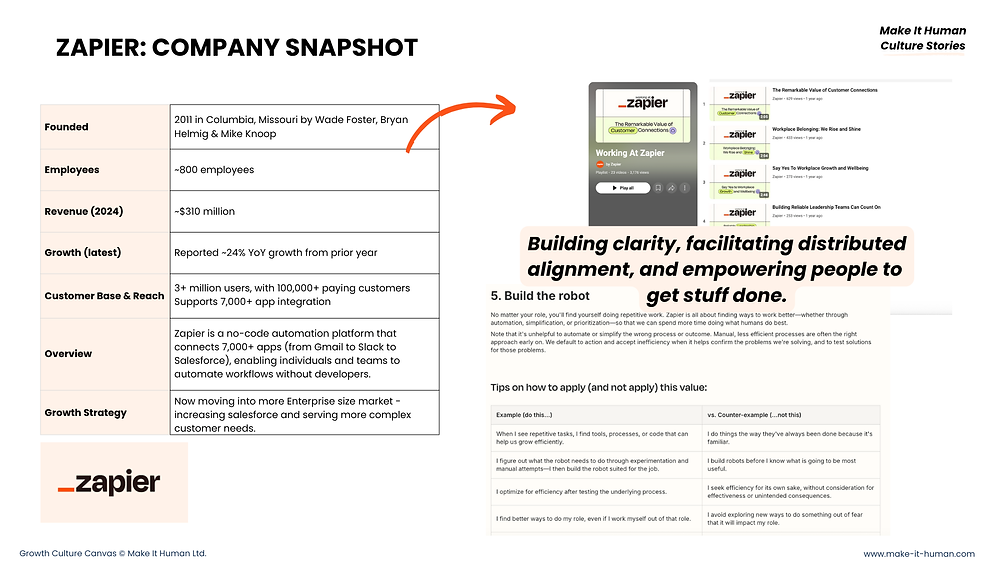
Culture Stories: The Inside Story of Zapier's Growth Culture (without meetings!)
0
25
0
Meet Less. Align More. How Zapier Built a Thriving Remote Culture
How do you keep 800 people, scattered across 40+ countries, aligned and energised — without defaulting to endless meetings?
That’s the question Zapier has been answering since the very beginning. Unlike many organisations forced into remote work during the pandemic, Zapier has been fully distributed since day one. And that has shaped everything about how they operate.
Zapier is best known for its no-code automation platform that connects 7,000+ apps. But their real innovation may just be cultural: they’ve built a thriving, connected, high-trust organisation without the usual meeting chaos that weighs so many teams down.
Async by Design — Not by Accident
For Zapier, async work isn’t an afterthought — it’s the default.
When your team spans continents and time zones, alignment can’t depend on who happens to be online at the same time. Instead, Zapier relies on written communication as its cultural backbone.
Rather than sending another calendar invite, people document decisions, progress, and context in shared, accessible spaces. That means anyone, anywhere, can pick up work without waiting for a meeting.
They even run regular “Get Stuff Done” weeks — no internal meetings, just space for deep, focused work. Meetings are used sparingly and with intent, often accompanied by pre-reads so time together is spent making decisions, not catching up.
Clarity and Connection in a Remote World
What’s striking is that Zapier hasn’t traded connection for efficiency.
They deliberately design for belonging: buddy systems for new hires, regular coffee roulette chats, and annual in-person retreats to build trust and human connection. Their YouTube channel offers a transparent window into how they work and communicate — with short explainers and career stories that make their culture visible, not hidden.
🔗 Peek inside their culture: Zapier Careers & Culture in the series of video shorts on their YouTube Channel:
Leadership by Example
This way of working only works if leaders live it. At Zapier, leadership models the behaviour they expect: async communication, transparency, and trust.
Managers act as coaches, not gatekeepers — their role is to unblock, not control. They help people act with autonomy by ensuring information flows freely. One of Zapier’s core values is “Default to action” — and leaders make sure that isn’t just a slogan.
🌍 Read their values: Zapier Values
A Culture That Scales Without Bureaucracy
As Zapier scales its product and team, this cultural foundation is what allows them to grow without drowning in meetings, bottlenecks or silos.
For any team facing meeting overload or struggling to keep distributed teams aligned, Zapier offers a powerful example:
Write it down.
Default to async.
Meet with purpose.
Design for belonging.
What We Learned in Coffee & Culture
This story was at the heart of our recent Coffee & Culture virtual meet-up. The discussion lit up quickly — many leaders in the group recognised the same struggles in their own organisations: too many meetings, unclear ownership, and the difficulty of staying aligned across dispersed teams.
A few reflections stood out:
💬 “Default to meetings is our biggest habit to break — what if we set the challenge to default to async instead?”
💬 “Giving people time to read and reflect before meetings could be a game changer.”
💬 “I love how deliberate Zapier is about what they don’t do — not just what they value.”
These conversations are why Coffee & Culture exists — to learn from real organisations doing things differently and to turn those lessons into practical steps we can try in our own workplaces.
“Default to meetings is our biggest habit to break — what if we set the challenge to default to async instead?”
Here are some practical actions you can try in your own team or organisation:
💬 Design belonging intentionally
Even in a distributed team, connection doesn’t happen by accident. Create rituals (buddy systems, coffee roulettes, async check-ins) that make everyone feel seen and included — wherever they are.
✍️ Make the unsaid visible
In async cultures, clarity is everything. Use written reflections, open channels and feedback rituals to surface what’s unresolved or slowing progress.
🗓️ Build shared clarity
Replace scattered conversations with shared docs and calendars. A single source of truth helps people act confidently without chasing context in endless meetings.
🌍 Lead with transparency
When leaders openly share context, decisions, and even mistakes, they build the trust that powers autonomous teams.
🧠 Build skills for async success
Zapier hires and develops people who communicate clearly in writing, manage their time well, and work with high trust. These aren’t “nice to haves” — they’re essential skills for distributed work.
Sources: Zapier website and YouTube channel. October 2025.
Join the Make It Human Club and download our 1-pager to help you adopt the Zapier way!
Bringing Culture Stories to Life
This blog is part of our new Culture Stories series in Coffee & Culture, our weekly 30-minute sessions where leaders, HR pros, and managers explore real-world examples of culture in action. Together, we break down what’s working, what isn’t, and what we can apply in our own workplaces.
➡️ Download the invite and join the next Coffee & Culture session:
And if you want to go deeper, the Growth Culture Canvas we used to map Airbnb’s culture is the same tool participants use in the Growth Culture Skills Accelerator — a practical, cohort-based programme where you’ll build your own growth culture plan.

🚀 Our next Accelerator cohort starts in January 2026. Join the waitlist to secure your spot.




